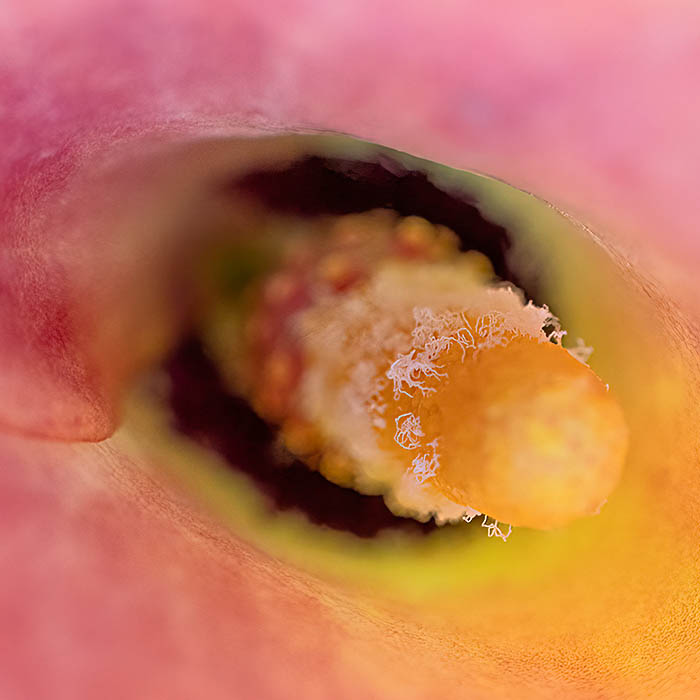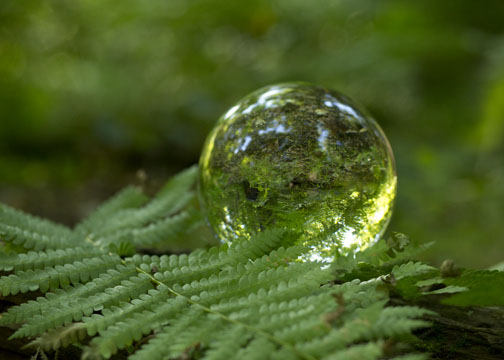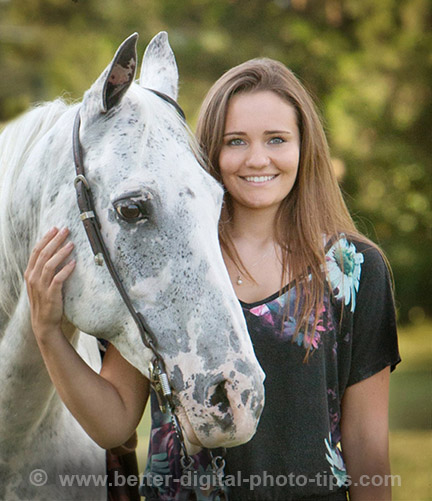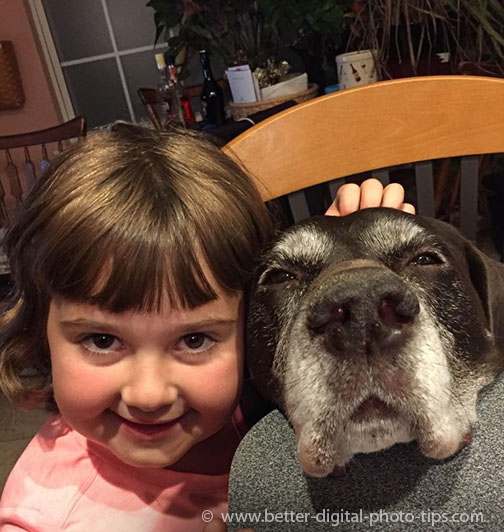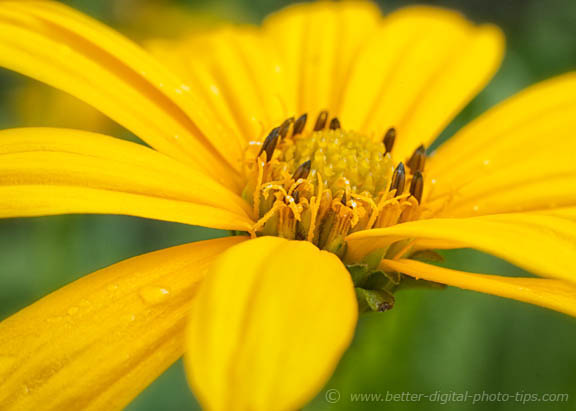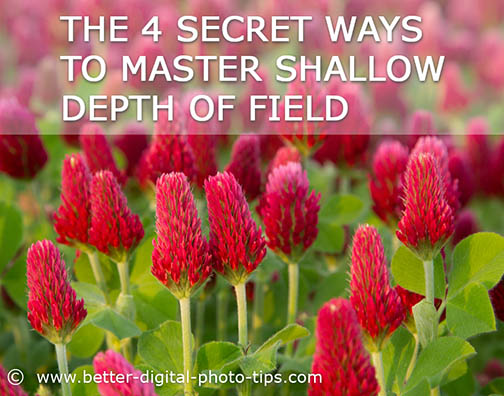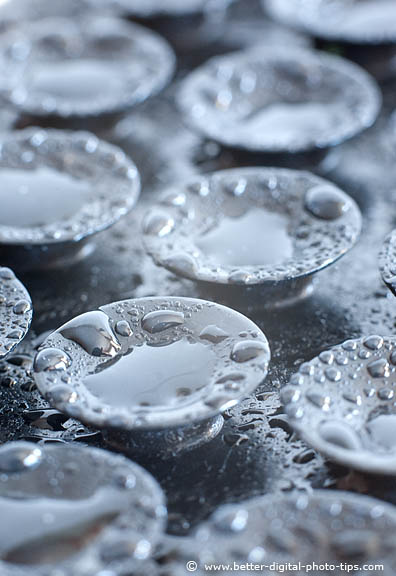HOW TO POSTS: LIGHTING AND COMPOSITION
shallow depth of field examples And How To get it
WRITTEN BY: BRUCE LOVELACE
UPDATED: July 6, 2024
Want to know more about shallow depth of field? It's also referred to as narrow depth of field. This post has a collection of small depth of field examples and gives you the 4 ways to minimize the depth of field. But first, check out the example below. I used 3 of the four techniques to produce a very shallow range of things in focus.
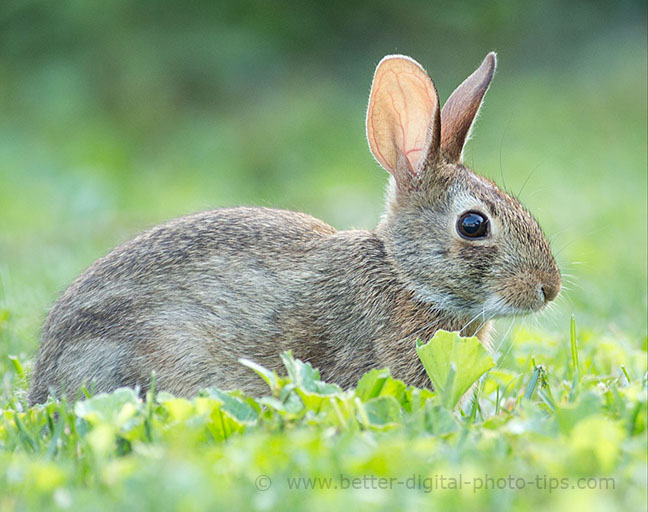 Only a very small range of distances are in focus.
Only a very small range of distances are in focus.1-Use a small f/stop number. 2-Zoom to full telephoto. 3-Get close to your subject.
This is a great example of how you can visually separate a subject from it's background by achieving a narrow depth of field. Just think about it. How cool is it to be able to take stunning photos by controlling the range on things in focus within your composition.
A narrow depth of field gives you a blurry background and often turns your average photo into a really nice photo. With a short depth of field you don't get distracted by objects that are in sharp focus in the background. Here are the 4 techniques to use to control the amount of depth of field.
How to get narrow depth of field
1. APERTURE-F/STOP
2. FOCUS DISTANCE
3. FOCAL LENGTH
4. SENSOR SIZE
- Use the smallest f/stop number you can. Small f/stop numbers like f/2.0 or f/4.0 will give you shallower depth of field.
- The closer the object that you focus on is to the camera, the less depth of field you will have. As you'll see in a minute, super close distances like macro photography give you a very small range of things within your photo that are sharply focused.
- Focal length. Use the longest zoom setting your lens is capable of.
- Sensor size. You can't control this if you are only using one camera, but if you have a choice, use a camera with the biggest sensor. Full-frame sensors give you the best potential to minimize your depth of field.
1. use a wide open aperture
Your choice of aperture is the most well known determining factor with depth of field. You must you a big lens open (the lowest numbered f-stop) to get a small amount of things in your macro photography pictures to be sharp.
 Extremely Short Depth of Field Range at f/1.8
Extremely Short Depth of Field Range at f/1.8You can create visually interesting images by photographing a series of repeating objects and using a wide open aperture to emphasize the focus on just one single object within the group.
2. shoot close to get shallow depth of field
Get as close to your subject as possible and your depth of field will diminish.
You can see that each one of these closeup photos used as examples in this article have a very limited depth of field. This first photo has just the right amount of shallow or "short," or "narrow" depth of field as it is sometimes called.
A smaller lens aperture was used and the background is still fairly out of focus, but sharp enough we can still identify the subject matter. Notice that in every one of these nature photos the sharply focused subject is placed near but NOT exactly in the middle of the composition.
Check out the close-up photo of the crystal ball in the woods below.
The easiest way to achieve a narrow depth of field is to get your subject as close as possible to the lens. It's actually usually a challenge to get enough range of sharp focus when doing macro-photography. Learning the different ways of controlling depth of field will prepare you to handle any situation.
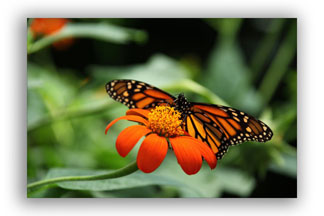
The bright orange of the sharply-focused butterfly make a nice color contrast with the out-of-focus, green foliage background. The splash of orange from the distant flower adds a bit of a secondary interest point which balances out the composition.
Bokeh is a another term that is related to narrow depth of field situations. Bokeh is often misunderstand as the amount of blurriness in the background. Here's more on Bokeh?
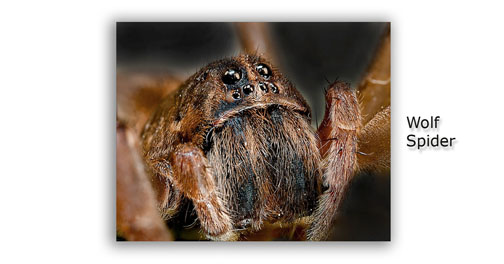 Macro Photography
Macro PhotographyThis extreme close-up of the Wolf Spider is enough to make your skin crawl. The distance range of parts in sharp focus is very small.
His hind legs are completely out of focus even though they are not that far away. It's the relative distance compared to the focus point distance to the lens that drastically cuts down on the range of things that are sharp.
3. use a long focal length Lens
Use the longest lens or lens setting you have. Zoom in as close as you can. You may have to be positioned at a farther distance to fit your subject within the frame.
This senior portrait was taken with my lens set at 200mm focal length. This is why portrait photographers like to shoot with telephoto zoom lenses. No matter where you are-what kind of environment you are in-you can create a nice out of focus background and put the emphasis on your model.
I set my lens opening to the widest setting possible with an 85mm prime lens. It was an f/1.8 aperture and it produced this remarkably small depth of field photo. It's often desirable to get a shallow or narrow depth of field when doing portrait photography, so a fast lens is popular with portrait photographers.
4. Use a camera with a large sensor
Look at the close-up below. It was taken with a cell phone camera. It's very difficult to achieve narrow depth of field with cameras that have small sensors. Cell phones are the perfect example of this. It's an adorable close-up, isn't it? It would have been even better if the background were more out of focus.
You can tell by the distortion that the camera was extremely close to the subject. Despite that close focusing, the objects in the background are still in fairly decent focus and are distracting.
You may only have one camera to choose from. But if you have a choice, larger DSLR and full-frame sensor cameras will give you the best results if you want to shoot shallow depth of field photographs. Here's a similar situation with a camera that has a large sensor.
 Big Sensor Camera = Less Depth of Field.
Big Sensor Camera = Less Depth of Field.last example of narrow depth of field
I used a small lens aperture of f/13, which normally gives you a deep depth of field, but because I was so close, the depth of field was still small. I am a nature geek and one of the things I marvel at is the intricacies of the inside of flowers.
Challenge yourself to create a few shallow depth of field photos and share them with the readers of better-digital-photo-tips.com.
Keep shooting. Keep learning. Keep improving.


ABOUT BRUCE LOVELACE
Bruce is the publisher of this website. He is the author of the book "Improve Your Photography Instantly." Read more on Bruce on his Bio Page. He's been known as The Traveling Photographer ever since 1994. Read more about this website.
View some of Bruce's photos on Instagram. Visit the Facebook Page. Watch him on YouTube. Bruce runs photo workshops for kids and adults, and provides one-on-one photography coaching.
Digital Photography Education Location on Google My Business

